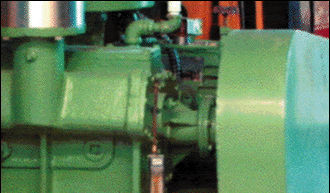Ruth A. Mondonsa
Anyone would agree that an undetected, uncontrolled fire is a menace that leaves disaster and destruction in its wake. When the fire happens to be invisible, as is the case with hydrogen fires, immediate detection is imperative. At the John C. Stennis Space Center in southern Mississippi, NASA's center for rocket propulsion testing, personnel face the danger of invisible fires every day. Testing and flight-certifying main engines for space shuttles is their job. The center is one of the world's leading consumers of liquid hydrogen.


The HC1000 multispectral imaging system in overlay mode shows the presence of an invisible fire. The same fire is not visible in the image captured with a standard video camera (below).
Thanks to NASA's Small Business Innovative Research Program, Duncan Technologies Inc. has developed an imaging system, the HC1000, that provides color images of invisible hydrogen fires. Engineers at the Stennis E-1 facility are using six camera systems to test hybrid rocket motors, turbomachinery and small rocket engines. At the E-2 facility the camera is being tested to monitor hydrogen flame stacks during turbopump and other rocket engine component testing.
The HC1000 combines a standard color video camera and two near-infrared cameras into a single unit. The system has embedded image processing to identify hydrogen or alcohol fires, which burn with an invisible flame. The user can choose to view any one of several output images. Unique is an "overlay" mode that shows the color video image with any hydrogen or alcohol fire present in the field of view "painted" on the image in bright red. Other output modes include the standard color image, the infrared image or an option to cycle through each of the modes.
In the past, technicians had to wave a corn-straw broom in the region of a suspected fire until it burst into flames, or throw dust into the air for a visible indication. Although better than these primitive methods, hydrogen fire detectors give only a general indication of location and no image. Thermal imagers provide flame images, but they can be difficult to interpret, and these devices can cost three to four times more than this new system.
In addition, Duncan Technologies' camera serves a dual purpose. When no fire is present, it acts as a standard color surveillance camera. When a fire is present, it creates an image of the flame combined with the color image to provide maximum information about the fire's location and size. An alert signal is available to notify the operator when there is a possible flame in the image, leaving technicians free to do other work.